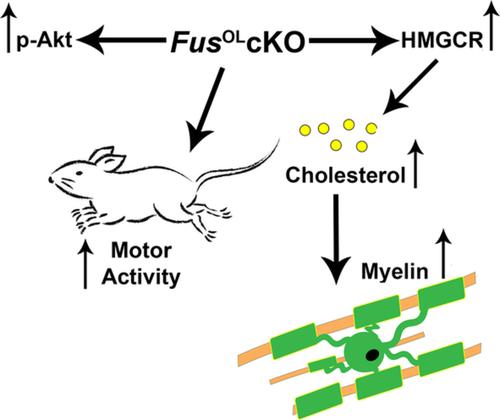Our official English website, www.x-mol.net, welcomes your
feedback! (Note: you will need to create a separate account there.)
Conditional depletion of Fus in oligodendrocytes leads to motor hyperactivity and increased myelin deposition associated with Akt and cholesterol activation.
Glia ( IF 5.4 ) Pub Date : 2020-03-18 , DOI: 10.1002/glia.23825 Kelly M Guzman 1 , Lauren E Brink 1 , Guillermo Rodriguez-Bey 2 , Richard J Bodnar 1 , Lisha Kuang 3 , Bin Xing 4 , Mara Sullivan 5 , Hyun J Park 6 , Erik Koppes 7 , Haining Zhu 3 , Quasar Padiath 2, 8 , Franca Cambi 1, 9, 10
Glia ( IF 5.4 ) Pub Date : 2020-03-18 , DOI: 10.1002/glia.23825 Kelly M Guzman 1 , Lauren E Brink 1 , Guillermo Rodriguez-Bey 2 , Richard J Bodnar 1 , Lisha Kuang 3 , Bin Xing 4 , Mara Sullivan 5 , Hyun J Park 6 , Erik Koppes 7 , Haining Zhu 3 , Quasar Padiath 2, 8 , Franca Cambi 1, 9, 10
Affiliation

|
Fused in sarcoma (FUS) is a predominantly nuclear multifunctional RNA/DNA‐binding protein that regulates multiple aspects of gene expression. FUS mutations are associated with familial amyotrophic lateral sclerosis (fALS) and frontotemporal lobe degeneration (FTLD) in humans. At the molecular level, the mutated FUS protein is reduced in the nucleus but accumulates in cytoplasmic granules. Oligodendrocytes (OL) carrying clinically relevant FUS mutations contribute to non‐cell autonomous motor neuron disease progression, consistent with an extrinsic mechanism of disease mediated by OL. Knocking out FUS globally or in neurons lead to behavioral abnormalities that are similar to those present in FTLD. In this study, we sought to investigate whether an extrinsic mechanism mediated by loss of FUS function in OL contributes to the behavioral phenotype. We have generated a novel conditional knockout (cKO) in which Fus is selectively depleted in OL (Fus OL cKO). The Fus OL cKO mice show increased novelty‐induced motor activity and enhanced exploratory behavior, which are reminiscent of some manifestations of FTLD. The phenotypes are associated with greater myelin thickness, higher number of myelinated small diameter axons without an increase in the number of mature OL. The expression of the rate‐limiting enzyme of cholesterol biosynthesis (HMGCR) is increased in white matter tracts of the Fus OLcKO and results in higher cholesterol content. In addition, phosphorylation of Akt, an important regulator of myelination is increased in the Fus OLcKO. Collectively, this work has uncovered a novel role of oligodendrocytic Fus in regulating myelin deposition through activation of Akt and cholesterol biosynthesis.
中文翻译:

少突胶质细胞中 Fus 的条件性消耗导致运动过度活跃和与 Akt 和胆固醇激活相关的髓鞘沉积增加。
Fused in sarcoma (FUS) 是一种主要是核多功能 RNA/DNA 结合蛋白,可调节基因表达的多个方面。FUS 突变与人类家族性肌萎缩侧索硬化 (fALS) 和额颞叶变性 (FTLD) 相关。在分子水平上,突变的 FUS 蛋白在细胞核中减少,但在细胞质颗粒中积累。携带临床相关 FUS 突变的少突胶质细胞 (OL) 有助于非细胞自主运动神经元疾病的进展,这与 OL 介导的疾病的外在机制一致。在全球范围内或在神经元中敲除 FUS 会导致与 FTLD 中存在的行为异常相似的行为异常。在这项研究中,我们试图调查由 OL 中 FUS 功能丧失介导的外在机制是否有助于行为表型。Fus在 OL 中被选择性耗尽 ( Fus OL cKO)。该毕淑敏OL CKO小鼠显示出增加的新奇诱导的运动活性和增强的探索行为,这让人想起FTLD的一些表现。表型与更大的髓鞘厚度、更多数量的有髓鞘小直径轴突相关,而没有增加成熟 OL 的数量。胆固醇生物合成限速酶 (HMGCR) 的表达在Fus OL cKO 的白质束中增加,导致胆固醇含量升高。此外,在Fus OL 中,Akt(髓鞘形成的重要调节剂)的磷酸化增加科。总的来说,这项工作揭示了少突胶质细胞Fus在通过激活 Akt 和胆固醇生物合成来调节髓鞘沉积方面的新作用。
更新日期:2020-03-18
中文翻译:

少突胶质细胞中 Fus 的条件性消耗导致运动过度活跃和与 Akt 和胆固醇激活相关的髓鞘沉积增加。
Fused in sarcoma (FUS) 是一种主要是核多功能 RNA/DNA 结合蛋白,可调节基因表达的多个方面。FUS 突变与人类家族性肌萎缩侧索硬化 (fALS) 和额颞叶变性 (FTLD) 相关。在分子水平上,突变的 FUS 蛋白在细胞核中减少,但在细胞质颗粒中积累。携带临床相关 FUS 突变的少突胶质细胞 (OL) 有助于非细胞自主运动神经元疾病的进展,这与 OL 介导的疾病的外在机制一致。在全球范围内或在神经元中敲除 FUS 会导致与 FTLD 中存在的行为异常相似的行为异常。在这项研究中,我们试图调查由 OL 中 FUS 功能丧失介导的外在机制是否有助于行为表型。Fus在 OL 中被选择性耗尽 ( Fus OL cKO)。该毕淑敏OL CKO小鼠显示出增加的新奇诱导的运动活性和增强的探索行为,这让人想起FTLD的一些表现。表型与更大的髓鞘厚度、更多数量的有髓鞘小直径轴突相关,而没有增加成熟 OL 的数量。胆固醇生物合成限速酶 (HMGCR) 的表达在Fus OL cKO 的白质束中增加,导致胆固醇含量升高。此外,在Fus OL 中,Akt(髓鞘形成的重要调节剂)的磷酸化增加科。总的来说,这项工作揭示了少突胶质细胞Fus在通过激活 Akt 和胆固醇生物合成来调节髓鞘沉积方面的新作用。











































 京公网安备 11010802027423号
京公网安备 11010802027423号